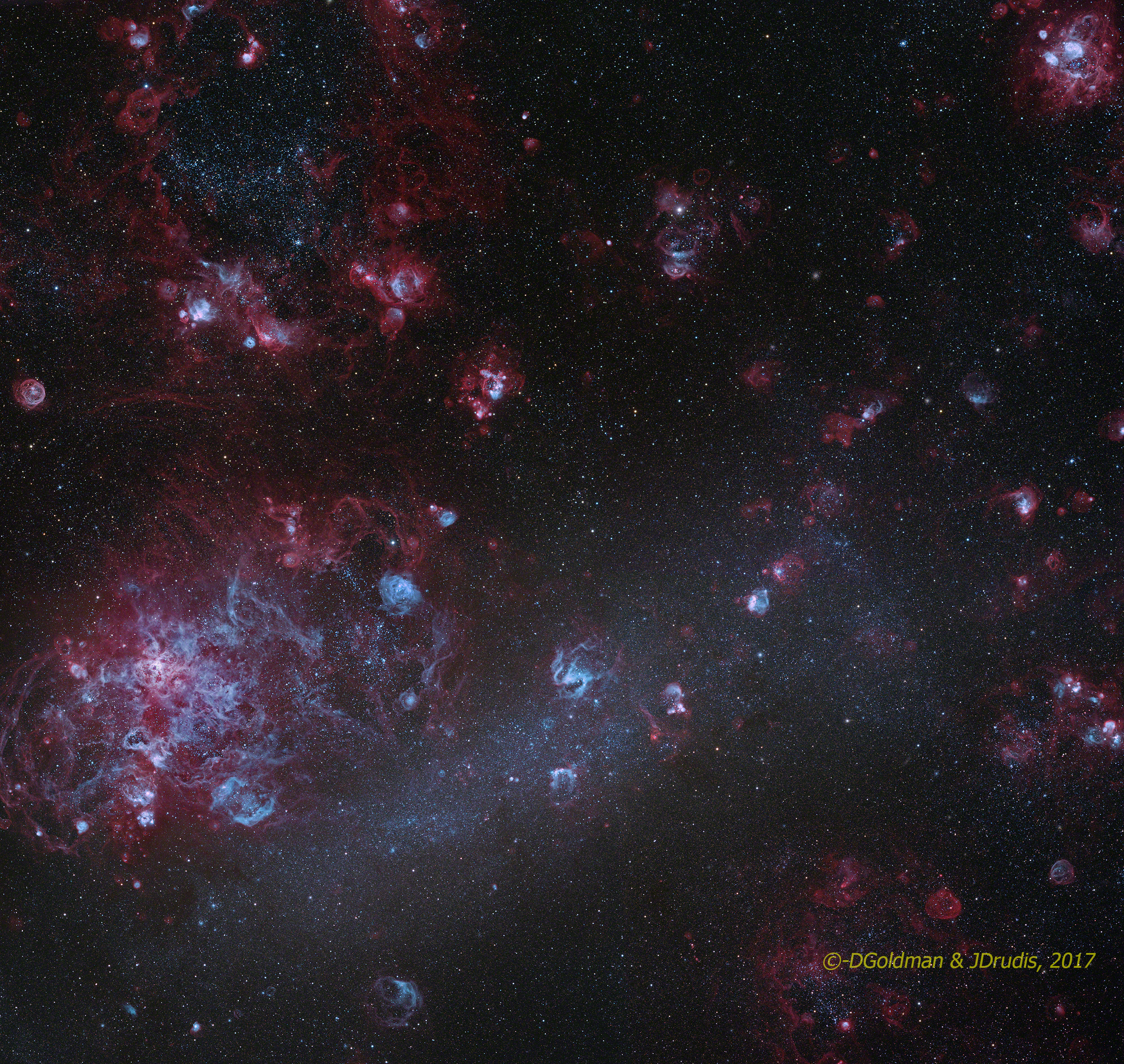
Click here for full resolution image
The Large Magellanic Cloud is a close satellite of the Milky Way. It forms, together with the Small Magellanic Cloud, a pair of galaxies (they orbit each other and, together, they orbit the MW) that have many things in common. Very especially, they are regions of a high star birth rate. This is better seen by the ratio of the mass of neutral Hydrogen (also called HI) to the luminosity of the galaxy in blue light. This ratio is, for the Milky Way, about 0.1. For the LMC, it is 0.3 and for the SMC, it is 1, ten times that of the MW.
This image is the result of a close collaboration with Don Goldman (I am his telescope partner at the SSO iTelescope site, Australia). It is a 2×2 mosaic, taken with the Takahashi TOA 130 f/5.7 and the SBIG 16803. This image stresses the region in the LMC that contains most nebulous systems, where many stars of the LMC are being born. In order to get a better contrast, a crispier image and a better differentiation between the chemical composition of this nebulae, the panels were imaged through narrow band filters (5nm H-alpha and 3nm OIII), but normal, long exposures through broad band RGB filters were also taken with the intention of getting real color of the stars as well as of the galaxy’s central band. The total exposure of these four panels is 44 hours 10 minutes (Ha: 16 h 20 m; OIII: 16 h; RGB: 10 h 50 m).
The mosaic panels (with only 10% overlap, to get a wider field) were registered with Registar (Auriga Imaging) taking a broad band image downloaded from the internet as a template. This method was suggested by Tony Hallas and proved to be an excellent approach. The resulting panels were then merged in Photoshop CC 2018. The filters were mapped to natural colors (Ha: Red and 15% Blue, OIII: Green and Blue). An additional increase in the resolution/crispiness of the image has been obtained by blending high resolution images of several nebulous components previously taken with a 20″ Planewave CDK20. These nebulae are: N70, NGC 2070 (the Tarantula Nebula, two sections), NGC 1968, N11, NGC 2035, NGC 2020, NGC 2014 and N44. Their superluminances (Ha and OIII) have been used for this purpose and blended in the original mosaic, to enhance its own superluminance. This methods increases the total exposure time involved in this image to 145.5 hours…
The huge number of different objects in this image cannot be simply enumerated and an annotated image is seen below. These annotations were produced with the assistance of Sakib Rasool.

Additional Information
Object
Name(s): Large Magellanic Cloud
Type: Spiral Galaxy type SBm
RA: 05h 21m 59s
Dec: -68º 20’ 12”
Constellation: Doradus
Size (arcmin): 15×13 degrees
Magnitude: +0.3
Distance: 170,000 ly
Image
Date: 2017-09-09 thru 2017-09-22
Location: iTelescope.net, SSO near Coonabarabran, NSW Australia
Size (arcmin): 4.7×4.7 degrees
Telescope: TOA 130mm f/5.7 and Planewave CDK 20” f/6.8
Camera: SBIG STX16803 (4096x4096pix)
Guiding: Astrodon MonsterMOAG off-axis guider
Total exposure: 44h10m (Ha: 16 h 20 m; OIII: 16 h; RGB: 10h 50m)
Processing: CCDStack, Registar, Photoshop CC 2018